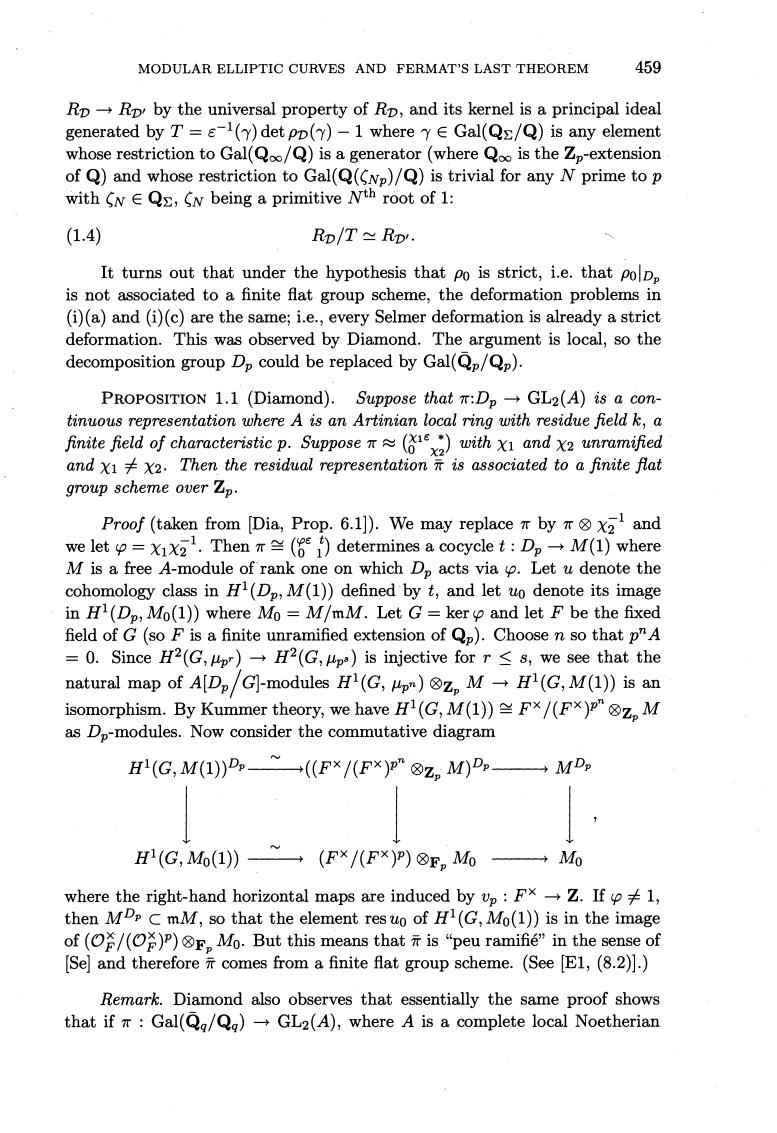正在加载图片...

MODULAR ELLIPTIC CURVES AND FERMAT'S LAST THEOREM 459 RD-Rp by the universal property of RD,and its kernel is a principal ideal generated by T=E-1()det pp()-1 where yE Gal(Qs/Q)is any element whose restriction to Gal(Q/Q)is a generator(where Qoo is the Zp-extension of Q)and whose restriction to Gal(Q(p)/Q)is trivial for any Nprime top with N E Qs,CN being a primitive Nth root of 1: (1.4) Rp/T Rp. It turns out that under the hypothesis that po is strict,ie.that polDp is not associated to a finite flat group scheme,the deformation problems in (i)(a)and (i)(c)are the same;i.e.,every Selmer deformation is already a strict deformation.This was observed by Diamond.The argument is local,so the decomposition group Dp could be replaced by Gal(Qp/Qp). PROPOSITION 1.1 (Diamond).Suppose that Dp-GL2(A)is a con- tinuous representation where A is an Artinian local ring with residue field k,a finite field of characteristic p.Suppose)with x1 and x2 unramified andx.Then the residual representationis associated to a finite fat group scheme over Zp. Proof(taken from [Dia,Prop.6.1]).We may replace r by x21 and we let =x1x21.Then (determines a cocycle t:Dp-M(1)where Mis a free Amodule of rank one on which D acts via.Let udenote the cohomology class in H(Dp,M(1))defined by t,and let uo denote its image in H1(Dp,Mo(1))where Mo M/mM.Let G=ker and let F be the fixed field of G(so F is a finite unramified extension of Qp).Choose n so that p"A =0.)is injective for,we see that the natural map of ADp/G]-modules H(G)MC,M(1))is an isomorphism.By Kummer theory,we have H1(G,M(1))FX/(FX)p"z M as Dp-modules.Now consider the commutative diagram H1(G,M(1))Dp- 一(Fx/(FxP8z,M)D, MDp (G,Mo(1)) 一(F×/(FX)P)8F,M M0 where the right-hand horizontal maps are induced by v :F×→Z.fp≠1, then MD CmM,so that the element resuo of H(G,Mo(1))is in the image of (/()P)F Mo.But this means that i is "peu ramifie"in the sense of [Se]and therefore comes from a finite flat group scheme.(See E1,(8.2)].) Remark.Diamond also observes that essentially the same proof shows that if Gal(Qa/Q)-GL2(A),where A is a complete local NoetherianMODULAR ELLIPTIC CURVES AND FERMAT'S LAST THEOREM 459 Rv +RVl by the universal property of Rv, and its kernel is a principal ideal generated by T = ~-l(y)det pv(y) -1where y E Gal(Qc/Q) is any element whose restriction to Gal(Q,/Q) is a generator (where Q, is the Z,-extension of Q) and whose restriction to Gal(Q(CNP)/Q) is trivial for any N prime to p with CN E QC, CN being a primitive Nth root of 1: It turns out that under the hypothesis that po is strict, i.e. that polDp is not associated to a finite flat group scheme, the deformation problems in (i)(a) and (i)(c) are the same; i.e., every Selmer deformation is already a strict deformation. This was observed by Diamond. The argument is local, so the decomposition group Dp could be replaced by Gal(Q,/Q,). PROPOSITION 1.1 (Diamond). Suppose that s:D, i GL2(A) is a continuous representation where A is an Artinian local ring with residue field k, a finite field of characteristic p. Suppose s FZ (;lEXJ) with XI and ~2 unramified and # ~2.Then the residual representation s is associated to a finite flat group scheme over Z,. Proof (taken from [Dia, Prop. 6.11). We may replace s by s @ X~land we let cp = XIX,l. Then sg (rIt) determines a cocycle t : D, iM(l) where M is a free A-module of rank one on which D, acts via cp. Let u denote the cohomology class in H1(Dp, M(1)) defined by t, and let u0 denote its image in H1(D, Mo(l)) where Mo = M/mM. Let G = ker cp and let F be the fixed field of G (so F is a finite unramified extension of Q,). Choose n so that pnA = 0. Since H2(G, ppr) + H2(G, p,~) is injective for r 5 s, we see that the natural map of A[D,/G]-modules H1(G, ppn) @zpM + H1(G, M(1)) is an isomorphism. By Kummer theory, we have H1(G, M(1)) g F /(F ')pn @zpM as Dp-modules. Now consider the commutative diagram where the right-hand horizontal maps are induced by v, : FXi Z. If cp # 1, then M~Pc mM, so that the element resuo of H1(G, Mo(l)) is in the image of (Og/(Og)P) @F~Mo. But this means that .fi is "peu ramifi6" in the sense of [Se] and therefore ?i comes from a finite flat group scheme. (See [El, (8.2)].) Remark. Diamond also observes that essentially the same proof shows that if s : Gal(Qq/Qq) + GL2(A), where A is a complete local Noetherian